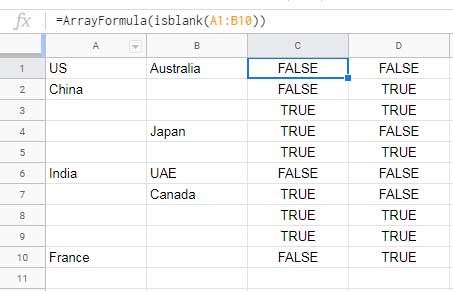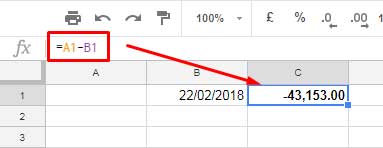ISBLANK and LEN are two functions that I always find useful in some sort of Google Sheets calculations. The function LEN has already found a space on this page. Now learn here how to use the ISBLANK function in Google Sheets. Its usefulness is more than what you think.
ISBLANK is an info type function in Google Sheets. That means the purpose of this function is to collect specific information about Spreadsheet Cells.
What is that specific information? You can use the ISBLANK function to check whether the referred cell is empty. To make maximum advantage of this function, you should use it together with IF.
The syntax of the Isblank Function in Google Docs Sheets:
ISBLANK(VALUE)How to Use of ISBLANK Function in Google Sheets
To learn the use of Google Sheets ISBLANK function I am taking you to a few examples.
In the following example, the content of Cell A1 is number 20. The below formula would return FALSE since the cell A1 is not Blank.
Formula:
=ISBLANK(A1)Result: FALSE
Now I’ve removed the value in Cell A1. Then the above same formula would return TRUE. In this example, the cell value is a number.
For your information, the cell value can be a number, text string, formula or even formula error. In all these cases, the ISBLANK formula result would be FALSE.
But I know some of you may have already found issues with Google Sheets ISBLANK function. Here are a few instances.
Why ISBLANK returns FALSE even though the reference cell is empty?
Many of you may have found that ISBLANK returns FALSE even if the cell content is blank. Is it a bug?
In my opinion, it may not be a bug in Google Sheets. It can be due to the following reasons.
See one IF logical formula. I’m applying this formula in Cell B1.
Here the value in Cell A1 is “Info Inspired” and the formula in B1 is as follows.
Formula:
=IF(A1="INFO INSPIRED","","WRONG ENTRY")Result: ""
You can see that the above formula returns a blank. Now I’m using one ISBLANK formula as below in any other cell.
Formula:
=ISBLANK(B1)Can you guess what would be the above ISBLANK formula output?
The value that returned by the logical test in cell B1 is blank. But the above formula would return FALSE because the blank cell is actually not blank, it’s "" but not visible.
Hope you could understand it. Similarly, if there are whitespace, newline or any hidden characters in a cell, the ISBLANK formula with reference to that cell would return FALSE only.
How to test multiple blank cells in Google Sheets
The ISBLANK function can be used in arrays. That means it can check multiple cells at a time.
Assume you want to test the range A1:A10 for blank cells. Then use this range in ISBLANK and wrap the entire formula with the ARRAYFORMULA function.
=ArrayFormula(isblank(A1:A10))The ISBLANK function can also test multiple columns at a time.
=ArrayFormula(isblank(A1:B10))
IF ISBLANK – The Practical Use of ISBLANK Function in Google Sheets
Let me explain here the IF ISBLANK combination use.
As I’ve mentioned above, ISBLANK is useful in logical tests. Especially in date-related calculations like finding the difference between two dates. In such cases the use of ISBLANK, LEN or other info type functions like ISDATE is unavoidable.
Let me explain it in detail.

Here as you can see, the Cell A1 is Blank. Then why B1 minus A1 returns some value? To understand this put the below date 30/12/1899 in Cell B1.
Now you can see that the formula above returns 0. Google Sheets considers blank cells in it contains a date input 30/12/1899.
So in date calculations, you can use ISBLANK as below to avoid unforeseen errors.
Similar Content: Learn Google Sheets complete date functions.
=IF(ISBLANK(A1),B1,A1-B1)This formula returns the date in B1 if the date in A1 is blank, else it returns the value of A1 minus B1. This way you can use ISBLANK function in Google Sheets to skip blank cells in date calculations.
There is a perfect alternative to ISBLANK in logical tests. In the above example, you can replace ISBLANK with LEN.
=IF(LEN(A1),A1-B1,B1)What is the difference between the above two formulas?
The difference lies in the logical tests.
In the first logical test that using ISBLANK, if it’s TRUE (A1 is blank) then return B1.
In the second logical test where I’ve used the LEN, if it’s FALSE (A1 is not blank) then return B1. The IF logical tests TRUE and FALSE logical expressions should be carefully used here.
That’s all. Enjoy.






















I have 3 cells with costs.
1 cell has the original cost, and the other 2 “could” have discount costs ($ and %) OR will be BLANK if not used.
If there is no discount on the original cost, I want the original cost to be displayed in the totals cell.
What would the formula be?
D3 and D4 are the outcomes for each discount ($ and %), whereas B3 is the original cost.
Thank you for your help.
Hi, Paul Jamieson,
This may help.
=if(sumproduct(isblank(D3:D4))=2,B3,"")How do you use it on multiple cells at once?
For example, if any cells of A1, A2, and A3 are blank, then return TRUE, else FALSE.
How can you do that?
Hi, Michael K,
For that, we can use COUNTIF with ISBLANK.
E.g.:
=ArrayFormula(countif(isblank(A1:A3),TRUE))>0If my findings are correct, conditional formatting in a cell causes ISBLANK() to return FALSE.
For example, I use conditional formatting to gray out a cell that is empty. In the case of an empty cell,
LEN()returns zero andISBLANK()returns FALSE.Hi, Philip Milazzo,
It’s strange!
Can you please replicate the error for me in an example Sheet?
Best,